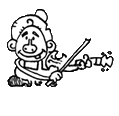How To Read FiddleHed Tabs
Tabs are an alternative to standard sheet music. They tell you which left-hand fingers to use and in what order.
But they don’t tell us what the rhythm is. In order to get the rhythm of each part, you either have to already know the tune or listen to it (either a play along track, video or another recording).
The idea is that you can use tabs to learn a tune and figure out left-hand fingerings. Once you know it, you can use the tabs as a reminder to jog your memory of the tune.
This system of tabs is somewhat unique to FiddleHed. It evolved organically through teaching fiddle lessons for twenty-three years. It is designed to get you learning as soon as possible.
Ultimately, I suggest you learn to read sheet music. Especially if you’re interested in learning longer, more complicated pieces.
Left-Hand Finger Numbers
Download and print:
Example: Oh Susanna
First quarter: (D0-1)-2-A0-0-1-0-D2-0-1-2-2-1-0-1
Second quarter: (D0-1)-2-A0-0-1-0-D2-0-1-2-2-1-1-0-0
Third quarter: D3-3-A1-1-1-0-1-0-D2-1-1
Fourth quarter: (D0-1)-2-A0-0-1-0-D2-0-1-2-2-1-1-0-0
To make the tabs easier to read, the letters don’t change if you’re on the same string.
For example, A0-1-2-1-D3 means you play four notes on the A string-open A, first on A, second on A, first on A, and then third on D string.
Duplicated parts are color coded to make them easier to read and to give you an overview of the structure. In the example above, the second and fourth quarters of the A part are identical so they are both color-coded red. Gray text indicates unique parts.
Brackets
( ) Notes in parentheses at the beginning of a tune or part indicate that this is a “pickup” to be played before the part. They lead smoothly into the part.
[ ] Brackets indicate that the notes are played as a triplet which is counted 1-2-3.
Notating two notes at once
D0A0=Double stop with open D and A
D1A0=Double stop with 1st finger on D (E note) and open A
Slides
⬆=Slide up to a note
⬇=Slide down to a note
Further learning
How To Learn Tunes From Recordings
Leave a Reply
You must be logged in to post a comment.



This is the first time I encountered the “double stop”, namely in the call-and-responses, so I had to google it. It means to play two strings at once.
Hi Adam, great point on that term. Thanks for sharing your experience and the definition you found.
Also, here are a variety of lessons and posts related to double stops on FiddleHed:
https://fiddlehed.com/?s=double+stop
I can read music but I’m not very fast at it so tabs help me a lot. To help me, I print out the sheet music and write the tabs over each note. By viewing the notes, I can tell if I should be playing eighth notes, quarter, or half notes. After I write the tabs, I study each measure and clap out the notes to get a better sense of the timing. I like your idea of saying the notes out loud as I play.